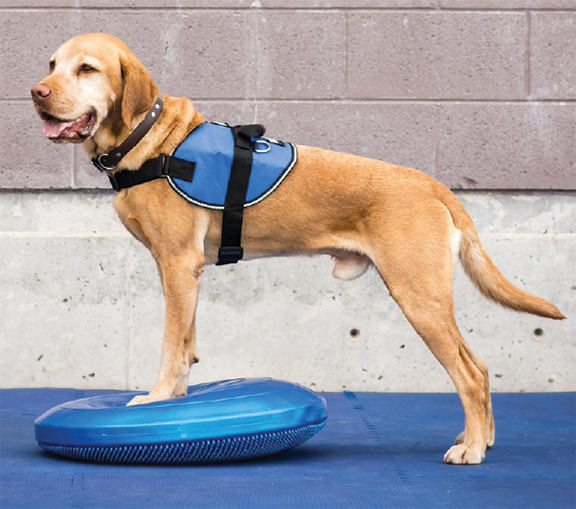As our beloved pets reach their golden years we may start to see signs that things aren’t quite the way they use to be. Maybe our dogs are not playing with their toys as much as they use to. Maybe they are not interacting with family members or other pets in the household as much, or maybe they get disoriented from time to time. When other medical reasons for behavior change have been ruled out these signs can be attributed to a decline in cognitive function in the brain. In a study of 180 dogs it was noted that 28% had signs of cognitive decline by age 11-12, and that number rose to 68% by age 15 (Landsberg & Araujo, 2005). Although we can’t stop the aging process no matter how much we wish we could, we can significantly slow down the process and even restore cognitive function through several approaches, one of those being through exercise and the use of the FitPAWS training methodology.
 Many parallels have been made between the aging human brain and the aging canine brain. Both experience deterioration and decline that show up in the form of some of the behaviors described above (Cory, 2013). Common recommendations include pharmaceutical support, dietary supplementation, and mental enrichment. One other recommendation that is gaining momentum is exercise. Not only has exercise been shown to increase brain volume, which can be lost as we age, but six months of aerobic exercise in humans increased executive function and reversed many aspects of age-related cognitive decline (Erickson & Kramer, 2009; Erikson, Leckie, & Weinstein, 2014). Research on canine aging has also shown positive results when exercise was included in a multipronged approach. Older beagles ages 11-14 were compared to young beagles (average age four) in their performance on learning tests in various conditions including a fortified diet and enrichment condition. The enrichment condition consisted of dogs that were housed in pairs that received two 20-minute walks per week. The fortified diet condition received a diet rich in fatty acids and other vitamins and minerals. The results showed that the combination of enrichment and a fortified diet had a significant effect on the dog’s cognitive abilities (Fahnestock, et al., 2012). Additionally, brain derived neurotropic factor, a protein responsible for enhanced neural conductivity among other things, was also shown to be significantly higher in the aged beagles on the fortified diets and in the enriched environments as compared to the control group; with levels being comparable to those of the younger dogs (Fahnestock, et al., 2012).
Many parallels have been made between the aging human brain and the aging canine brain. Both experience deterioration and decline that show up in the form of some of the behaviors described above (Cory, 2013). Common recommendations include pharmaceutical support, dietary supplementation, and mental enrichment. One other recommendation that is gaining momentum is exercise. Not only has exercise been shown to increase brain volume, which can be lost as we age, but six months of aerobic exercise in humans increased executive function and reversed many aspects of age-related cognitive decline (Erickson & Kramer, 2009; Erikson, Leckie, & Weinstein, 2014). Research on canine aging has also shown positive results when exercise was included in a multipronged approach. Older beagles ages 11-14 were compared to young beagles (average age four) in their performance on learning tests in various conditions including a fortified diet and enrichment condition. The enrichment condition consisted of dogs that were housed in pairs that received two 20-minute walks per week. The fortified diet condition received a diet rich in fatty acids and other vitamins and minerals. The results showed that the combination of enrichment and a fortified diet had a significant effect on the dog’s cognitive abilities (Fahnestock, et al., 2012). Additionally, brain derived neurotropic factor, a protein responsible for enhanced neural conductivity among other things, was also shown to be significantly higher in the aged beagles on the fortified diets and in the enriched environments as compared to the control group; with levels being comparable to those of the younger dogs (Fahnestock, et al., 2012).
 As our pets get older we want to be able to preserve, optimize, and re-engage cognitive processing, learning and memory, and executive functions that are lost through the process of aging (Tapp et al., 2003). One of the key ways to accomplish this is by exercising our dogs on a regular basis. As you can see from the research above, exercise is not only for those dogs who need to stay in tip top shape for competition, or for those who need to lose a couple extra pounds. Exercise using FitPAWS training equipment under the guidance of a Master Trainer or Certified Canine Fitness trainer can help the aging canine client stay healthy and cognitively fit throughout their golden years.
As our pets get older we want to be able to preserve, optimize, and re-engage cognitive processing, learning and memory, and executive functions that are lost through the process of aging (Tapp et al., 2003). One of the key ways to accomplish this is by exercising our dogs on a regular basis. As you can see from the research above, exercise is not only for those dogs who need to stay in tip top shape for competition, or for those who need to lose a couple extra pounds. Exercise using FitPAWS training equipment under the guidance of a Master Trainer or Certified Canine Fitness trainer can help the aging canine client stay healthy and cognitively fit throughout their golden years.
 About the Author: Genevieve Cahill, founder of Modern Animal Behavior has been a Certified Veterinary Technician for 15 years. All throughout her life she has been very passionate about two subjects, fitness and behavior. She completed her two undergraduate degrees in Psychology and Communication and is now pursuing her Masters Degree in Companion Animal Behavior Counseling. Recently, Genevieve found a way to merge her two passions via the FitPAWS Master Trainer/ University of Tennessee Canine Fitness Trainer program and her masters thesis work researching how exercise enhances learning/behavior in shelter dogs. Genevieve believes that behavior and exercise can be completely intertwined and is passionate about bringing that message to pets and their owners. Genevieve’s background as a Certified Personal Trainer through the National Academy of Sports Medicine (NASM) and her many years as a Veterinary Technician have prepared her to jump right into this up and coming world of canine fitness.
About the Author: Genevieve Cahill, founder of Modern Animal Behavior has been a Certified Veterinary Technician for 15 years. All throughout her life she has been very passionate about two subjects, fitness and behavior. She completed her two undergraduate degrees in Psychology and Communication and is now pursuing her Masters Degree in Companion Animal Behavior Counseling. Recently, Genevieve found a way to merge her two passions via the FitPAWS Master Trainer/ University of Tennessee Canine Fitness Trainer program and her masters thesis work researching how exercise enhances learning/behavior in shelter dogs. Genevieve believes that behavior and exercise can be completely intertwined and is passionate about bringing that message to pets and their owners. Genevieve’s background as a Certified Personal Trainer through the National Academy of Sports Medicine (NASM) and her many years as a Veterinary Technician have prepared her to jump right into this up and coming world of canine fitness.
Cory, J. (2013). Identification and management of cognitive decline in companion animals and the comparisons with Alzheimer disease: A review. Journal of Veterinary Behavior, 8(4), 291-301.
Erikson, K.I., Leckie, R.L., & Weinstein, A.M. (2014). Physical activity, fitness, and grey matter volume. Neurobiology of Aging, 35, 520-528.
Erickson, K.I. & Kramer, A.F. (2009). Aerobic exercise effects in cognitive and neural plasticity in older adults. Br J Sports Med., 43(1), 22-24. doi:10.1136/bjsm.2008.052498.
Fahnestock, M., Marchese, M., Head, E., Pop, V., Michalski, B., Milgram, W.N., & Cotman, C.W. (2012). BDNF increases with behavioral enrichment and an antioxidant diet in the aged dog. Neurobiol Aging, 33(3), 546-554. doi:10.1016/j.neurobiolaging.2010.03.019.
Landsberg, G., & Araujo, J.A. (2005). Behavior problems in aging pets. Veterinary Clinics, 35, 675-698.
Tapp, P.D., Siwak., C.T., Estrada, J., Head, E., Mugggenburg, B.A., Cotman, C.W., & Milgram, N.W. (2003). Size and reversal learning in the beagle dog as a measure of executive function and inhibitory control in aging. Learning and Memory, 10, 64-73.

